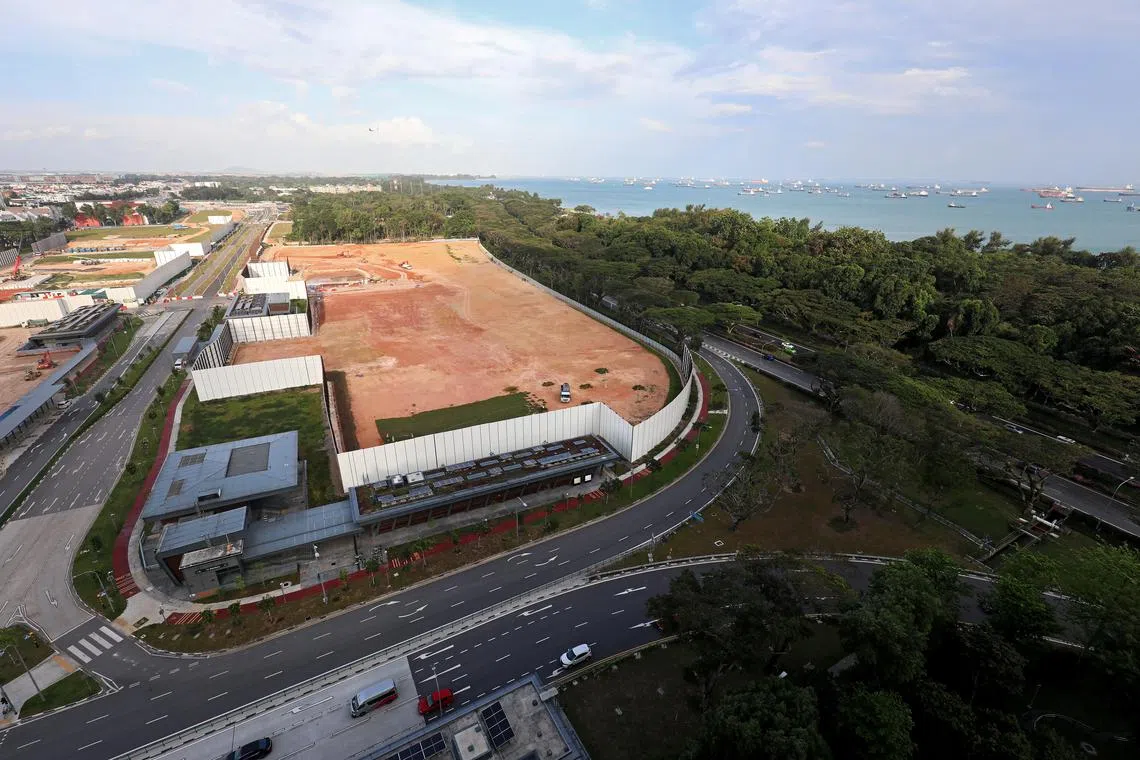Competitive bids for state land tenders lifting land betterment charges for non-landed residential use
Sign up now: Get ST's newsletters delivered to your inbox

The increase in land betterment charge rates was most significant in areas such as Bayshore (above), East Coast Park and Serangoon.
PHOTO: LIANHE ZAOBAO
Follow topic:
- Land Betterment Charge (LBC) rates for non-landed residential use will increase by 0.7% on average, driven by renewed landbanking interest.
- Bayshore saw the highest increase (15.4%), reflecting the $1,388 psf ppr benchmark GLS price. One-north rates dropped by 3%.
- Landed residential LBC rose 0.4%, reflecting demand in Holland Road, Bukit Timah and Thomson Road
AI generated
SINGAPORE - Renewed interest in recent state land tenders has driven up land betterment charge (LBC) rates for non-landed residential use in the next half year.
Developers pay an LBC for the right to enhance the use of some sites or to build bigger projects on them.
The latest LBC rates for the period from Sept 1, 2025, to Feb 28, 2026, were announced on Aug 29, following a review by the Singapore Land Authority in consultation with the taxman’s chief valuer.
The LBC rates are based on the chief valuer’s assessment of land values and take into consideration recent land sales.
For non-landed residential use, LBC rates will rise by a further 0.7 per cent on average after gaining an average of 0.3 per cent in the previous revision period of March 1 to Aug 31.
ERA Singapore key executive officer Eugene Lim noted that the increase in LBC rates was most significant in areas such as Bayshore, Siglap, East Coast Park and Serangoon, where several Government Land Sales (GLS) sites have been sold in recent months.
“The tweaks in LBC rates are aimed at catching up with recent land price increases. Specifically, the Bayshore area recorded the highest increase of 15.4 per cent, reflecting a benchmark GLS price of $1,388 per sq ft per plot ratio (psf ppr) for the Bayshore Road site,” he said.
Located next to Bayshore MRT station, the plum site was awarded at $658.9 million or $1,388 psf ppr to a tie-up between SingHaiyi Group and Haiyi Holdings in March.
The Lorong Chuan area reported a 9.5 per cent increase in LBC rates, which Mr Lim said reflected the award of the Chuan Grove GLS site
“In the absence of residential collective sales concluded in the preceding half-year, LBC revisions for non-landed use largely tracked the performance of state land tenders, which have recently seen stronger participation,” CBRE head of research in Singapore and South-east Asia Tricia Song said.
This comes on the back of lower interest rates, which have lightened borrowing costs for developers and home buyers, she added.
The second-highest increase in non-landed residential LBC rates was 12 per cent for two sectors – the East Coast Park area; and the reclaimed land area south of Katong Park MRT station and south-east of Tanjong Rhu, said Mr Nicholas Mak, chief research officer at property search portal Mogul.sg.
Mr Karamjit Singh, chief executive of property consultancy Delasa, noted that this increase in LBC for the stretch of undeveloped land bound by the Marina Coastal Expressway, East Coast Parkway and the sea “could be a prelude to the release of some land parcels for housing soon.”
Only one sector saw a drop in the LBC rate – the one-north area – of 3 per cent. This could be because of the results of the Media Circle (Parcel A) state land tender in March, Mr Singh added. The plot, zoned as residential with commercial at first storey, can yield about 325 private homes.
Qingjian Realty, Forsea Residence, and a third partner bagged the Media Circle site for nearly $1,037 psf ppr – below what was paid for another nearby Media Circle site at $1,191 psf ppr in January 2024.
In comparison, for landed residential use, LBC rates will rise by 0.4 per cent on average, compared with a 3 per cent jump in the previous revision period.
Within the landed use segment, the LBC for 13 sectors will see an increase ranging from 3 per cent to 5 per cent, reflecting rising demand in the landed enclaves of Holland Road, Bukit Timah and Thomson Road, Ms Song said.
For commercial use, LBC rates will edge up a marginal 0.1 per cent on average, compared with a 0.6 per cent rise in the previous revision period.
“Office-dominant sectors such as those in the CBD remained flat, while sectors in the main shopping belt such as Orchard were flat after increases in the previous round,” Ms Song said.
LBC rates for industrial use will climb 1.6 per cent on average after edging up 0.1 per cent in the previous revision period.
For this sector, the highest LBC rate increase of over 9 per cent was in the areas of Kallang, MacPherson, Ubi and Tai Seng, boosted by the collective sales of MacPherson Industrial Complex and Ching Shine Industrial Building, Mr Singh said.
LBC rates for hotels, hospitals and nursing homes will be unchanged, after a 0.6 per cent growth in the previous revision period.
LBC rates for place of worship/civic and community institution use will rise 2.9 per cent on average, following a 6 per cent jump on average in the previous revision period.
JLL’s head of research and consultancy for South-east Asia Chua Yang Liang pointed out that while LBC rates constitute a small portion of overall development cost, they are applied to the additional portion of development that exceeds the approved density.
“These refreshed rates should not have any significant drag on the market trend or dampen developers’ and investors’ confidence in the underlying property market,” he said.


